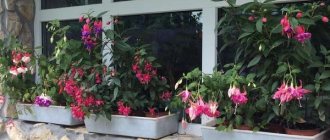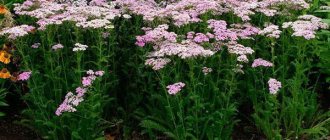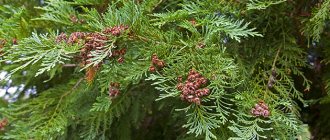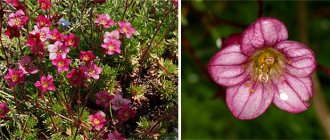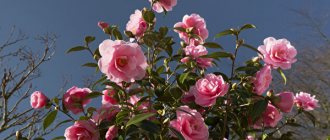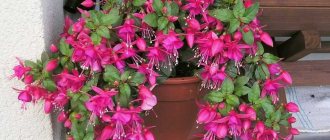Hybrid fuchsia is a popular garden and indoor plant; it does not overwinter in open ground in Russia. In the West, it is often grown as an annual crop; at best, the queen cells are left until spring for propagation. The most versatile is the ampelous fuchsia - it can be planted in a hanging basket, a stationary flowerpot, a flower pot or in a high flowerbed.
Botanical description
Fuchsia is a genus of woody perennials from the fireweed family, which includes about 100 species. Comes from the humid tropics and subtropics of Central and South America, Tahiti, New Zealand.
Appearance
In their homeland, fuchsias are mostly evergreens. In Russia they behave like deciduous perennial trees or shrubs.
The leaves of the crop are collected in whorls of 3-5 pieces or opposite. The length ranges from 1 to 25 cm, but usually within 4-5 cm. The plates are simple, pointed, with a finely toothed edge, elongated oval in shape. The color is green or reddish, there are variegated varieties.
Fuchsia shoots can be relatively flexible and thin, or rigid and erect. The vast majority of cultivars have untrimmed stems that are something in between. Over time, the branches become woody and covered with beige bark.
Bloom
Fuchsia buds form at the tips of the current year's shoots. Flowers consist of two parts, the color of which can be the same, different or differ in shade:
- The calyx is 4 lanceolate, with pointed tips of the lobes, fused at the base into a long tube. After the fuchsia buds have fully bloomed, they are located perpendicular to the petals or slightly cover the base of the corolla, but more often they are bent back to varying degrees. In the latter case, the sepals can be straight, curved, like a bow string, or even slightly twisted. Color: white, all shades of pink or red.
- The fuchsia corolla is often much shorter than the sepals, simple, with 4-5 petals, or terry, looking like a fluffy skirt. The color of the corolla can be white, different shades of pink, red, blue, light blue, violet. Sometimes the petals are painted with contrasting streaks or strokes.
Fuchsias can also be distinguished by their long anthers and pistil protruding beyond the corolla. In ampelous varieties, the buds are attached to a long drooping pedicel and range in size from 1 to 10 cm.
Under natural conditions, the crop is pollinated by hummingbirds. After fertilization, dark purple berries measuring 5-25 mm are set. In most species they are edible and taste like a mixture of citrus and black pepper.
Recommended species and varieties
Among fuchsias, groups of relatively cold-resistant and heat-loving plants can be distinguished.
- Cold-resistant species and varieties
The cold resistance of these fuchsias is only relative. In principle, they can winter in regions with warm winters (on the Black Sea coast) if they grow in well-drained soil and a place sheltered from the winds. Under unfavorable conditions, these fuchsias behave like herbaceous perennials: the aboveground part dies from frost, and in the spring new shoots grow from underground at the base of the bush.
F. magellanica (F. Magellanica)
A bushy plant, the most winter-hardy of the genus. It is characterized by dark crimson sepals, purple petals and prominent stamens. In the most favorable conditions, it can reach a height of 3 m. The flowers are small, about 4 cm long and 2 cm in diameter. The leaves are green, opposite, oblong-oval, pointed, up to 7 cm long. The height and diameter of the plant is 1.2x0.5 m.
bushy plant
Var. gracilis "Aurea"
The bright red sepals and purple petals of this variety look very impressive against the background of narrow golden leaves. The plant has thinner branches than the original species and arched stems.
Var. gracilis "Aurea"
Var. gracilis “Variegata”
The same color is characteristic of the flowers of this variety, but the plant is less tall than the previous one: up to 60 cm in height and up to 60 cm in diameter. Leaves with creamy yellow edges.
Leaves with creamy yellow edges
Var. molinae (syn. “Alba”)
The leaves are light green, white sepals and pastel lilac petals.
Leaves are light green
“Sharpitor” (syn. F. “Overbecks”, F. “Sharpitor”)
The flowers of the cultivar have the same color, which bears gray-green leaves with white edges and reaches 75 cm in height and 60 cm in diameter.
Varieties and varieties
Official sources write that there are more than 2000 fuchsia cultivars. Fans claim that there are from 16 to 22 thousand of them in catalogs. It is impossible to determine the exact quantity without a unified database.
One of the most controversial topics is what variety fuchsia belongs to:
- bush (upright) with rigid, erect shoots;
- semi-ampeloid (lax variety) – first grows upward, droops with age;
- hanging (trailer, pendula) - with thin hanging branches.
There are very few varieties that clearly show the characteristics of the first or third group in any conditions. The majority belongs to the second.
Semi-ampeloid fuchsias can grow strong straight or flexible thin shoots, depending on cultivation and care at home. Whether the bush will be ampelous is influenced by lighting, pruning, and fertilizing.
Experienced gardeners skillfully use this and form plants at their own discretion.
There are ampelous fuchsias with barely enough shoots to cover the container, or with very long stems.
Kirsus Spangles
Circus Spangles is an American large-flowered variety from 1990 with white sepals slightly touched with pink. The skirt is terry, round, the color depends on the growing conditions, it can be raspberry or cherry.
White and red-orange strokes are possible on the petals. The variety is half ampelous.
Bora Bora
Bora Bora - fuchsia of American selection (1966). The sepals are reflexed, white, the corollas are densely double, the skirt is blue, with pale pink large strokes.
Whether the variety will be ampelous depends on its formation.
Marinka
Marinka grows as a bush at a young age. Then the branches begin to bend, the fuchsia turns into an ampelous one.
The flowers are simple, rarely semi-double, the sepals are bright red, the petals are crimson.
Millennium
Millenium is an ampelous variety.
The skirt, depending on the place of planting and care, is very dark burgundy or almost black, the sepals are of a rare purple color.
Blue Angel
Blue Angel is a fuchsia with huge flowers, up to 12 cm.
The sepals are snow-white, the terry skirts are blue. Ampel bush.
Blackie
Fuchsia Blacky is distinguished by crimson sepals bent almost to the peduncle and coal-violet, almost black corollas.
When describing the variety, different sources call it erect or ampelous. The growth pattern depends on how the plant is formed.
Southgate
The name Southgate translates as Southern Gate. Medium-sized soft pink flowers abundantly cover the half-ampeled bush.
The shade of the sepals is slightly darker than that of the terry corollas.
Blue Eaz
Fuchsia Blue Eyes is an ampelous variety with several rows of petals.
The flowers are red-blue, double, large, pink stamens.
Brief description of the plant, types, varieties
Under natural conditions, fuchsia is found in the forests of America and New Zealand and has the appearance of a lush shrub with long flexible branches. It blooms for a long time, the leaves acquire a reddish tint in the sun.
Indoor fuchsia is a compact spreading or ampelous plant with a pyramidal or straight stem. The leaves of the bush are dark green, pointed in shape, with small jagged edges. The flowers consist of a corolla with curved edges and a calyx, drooping, with long petals and stamens.
The variety of shades of regular and double flowers in fuchsia is amazing. Popular colors among gardeners include white, violet, soft pink, purple, cream, lilac, and orange-red.
Some experimenters grow a flower at home in the form of a spreading ampel, a vine hanging from a flowerpot, a low standard bush of an interesting shape, and even a bonsai.
It is important to know. The plant is characterized by seasonality: from spring to autumn it grows actively, from June it pleases with beautiful flowers, and in the fall it requires rest - less watering and lowering the temperature in the room.
The most popular fuchsia varieties are combined into 3 groups.
- Hybrid. Thanks to selection, several thousand varieties with different flower colors have been isolated. The most famous names are Marinka, Annabelle, Santa Clara.
- Small-flowered. This includes 6 subspecies - Magellan, graceful, Bolivian, brilliant, trifoliate and recumbent.
- Large-flowered. All representatives of this group have the same name - beautiful fuchsia.
In the photo below you can see what the most beautiful varieties with bright bell buds look like:
- Auntie Jinks;
- Blue Eyes;
- Maori maid;
- Pink Galore;
- Seventh Heaven.
Planting at home
Ampelous fuchsia should be planted 2-3 cuttings in one container:
- Drainage is placed in the pot, the substrate is filled, holes are made according to the shape and size of the root system of young plants.
- Rooted shoots or grown seedlings are taken out of the cups and planted without deepening the central stem.
- Watered.
- If the fuchsia is weak or the root is poorly developed, cover it with a glass cap or cellophane.
- Place in a slightly shaded place.
Strong plants with a powerful root system only need protection from bright sun for 2-3 days and regular spraying of the crown.
Soil requirements
Ampelous fuchsia loves soil with a slightly acidic reaction. It should be structured, loose, and allow water and air to pass through well until the next transplant.
You can use a ready-made substrate for violets or geraniums. Many gardeners who practice intensive care and do not forget about fertilizing grow fuchsias, including hanging ones, in a mixture of peat and coconut fiber. The last component is needed so that in case of accidental drying, you do not place the pot in a bucket of water - peat tends to clump together, dry peat does not absorb liquid well, and coconut fiber absorbs it instantly.
If the owners prefer soil substrates, you can mix equal shares:
- turf soil;
- rotted leaves;
- humus;
- sand;
- sour peat.
Choosing a pot
It is better to grow ampelous fuchsias in ordinary containers. And then put them in a flower pot or hanging basket and take them outside to the balcony.
The container should be proportional to the root, quite close, but containing at least 1 liter of substrate per adult bush. Flowering will begin only when the adventitious shoots entwine the clump.
You can hear the objection that ampelous fuchsia perfectly forms buds in large flowerpots. But not one, but several plants are planted there at once, otherwise it is difficult to obtain a lush, beautiful bush, especially with cascading ampelous varieties.
It is better to take a plastic pot for fuchsia, with several large holes; be sure to place drainage at the bottom. It is needed:
- so that excess moisture does not stagnate in the root area;
- to improve aeration, which is no less important.
The design of a flowerpot or hanging basket is not particularly important. If you care for the ampelous fuchsia correctly, it will cover the walls with flowering vines.
Features of care at home and outdoors
The general rules are mostly the same, although there are differences. Despite the fact that fuchsia comes from the tropics or subtropics, growing the flower in southern gardens is a big problem due to the heat, whiteflies, and overheating of the root system.
Selecting a location
Ampelous fuchsia loves fresh air, but indoors, thanks to air conditioning, it is easier to control the temperature. The plant prefers very moderate temperatures, no more than 20-24° C.
Lighting needs to be intense, bright, but without direct midday rays:
- on the southern window sill protection in the form of a light curtain is required;
- in open ground - planting next to a fence, buildings or larger plants that cover the hanging fuchsia in the middle of the day.
The culture tolerates light partial shade; some cultivars can bloom in poor light, but not in deep shade. In flowerpots, bushes can be placed under a canopy or attached to the branches of a tree with an openwork crown.
Ampelous fuchsias are not planted in flat flower beds - when they come into contact with the ground, the long shoots begin to rot. But they can be placed on tall or terraced flower beds, or in stationary flowerpots.
Watering
Regular irrigation is needed, some sources recommend that the soil be constantly moist, others advise drying it out by a few millimeters. In summer, fuchsia may require daily watering. In flower beds, the soil is mulched with peat or bark to retain moisture; in pots, with sphagnum.
In cool weather and before the dormant period, watering is reduced.
Air humidity needs to be high. In hot weather, the bushes are sprayed several times a day, trying not to get it on the flowers.
Feeding
In the spring, to resume the growing season, grow new shoots and leaves, ampelous fuchsia needs nitrogen; during flowering, phosphorus, potassium plus microelements. The plant especially suffers from magnesium deficiency.
Every 2 weeks in the middle of the season, use complex mineral fertilizers for flowers with the same content of macroelements, for example, 10:10:10 or 20:20:20. Long-acting fertilizers can be used in potted crops.
From the end of summer, nitrogen is eliminated. Feed with phosphorus and potassium preparations.
Formation
Ampelous fuchsia blooms on the tops of the current year's shoots, but only a branched bush will be beautiful. You will have to sacrifice early flowering.
The following algorithm is suitable for young or adult plants, barely rooted cuttings:
- Branches that have grown a little after winter are pinched over 2-3 pairs of leaves.
- The same is done with all the side shoots until the bush takes on a beautiful lush shape.
Depending on the variety and care, 6-12 weeks will pass from the time of the last pinching to the flowering of the ampelous fuchsia.
At the peak of decorativeness, faded corollas and yellowed leaves are removed, and elongated thin shoots are shortened. In case of accidental pollination, which happens extremely rarely, it is better to remove the fruits - nothing worthwhile will grow if you collect the seeds.
At the end of the season, after the leaves of the ampelous fuchsia begin to fly off, the bush needs to be pruned. In hanging varieties, the shoots are shortened by about a third.
Transfer
Transshipment is allowed without disturbing the earthen coma of a flowering plant, although it is better to do this annually in the spring. The operation cannot be performed:
- during the dormant period, when some of the roots die off, life processes are suspended;
- at high temperatures – the crop does not tolerate heat well.
If you are going to plant ampelous fuchsia in open ground, do it after the ground has warmed up to 15° C. The above-ground part of most species and varieties tolerates a short-term decrease to 0° C, holds well at 5° C, but the root does not work, the buds may fall off , even leaves.
Wintering
In potted crops, reduce watering. Bushes are dug out from open ground after the leaves begin to fall, but the thermometer should not cross the zero mark even at night.
The ampelous fuchsias are trimmed by 1/3. Pick off the remaining leaves. Put away for storage.
Wintering on a northern windowsill is only suitable for young plants grown this season from cuttings or seeds. They should remain with the leaves unless they fall off on their own.
The rest of the fuchsias are sent to a frost-free basement, on a glazed balcony. Temperature:
- should not exceed 12° C;
- it is better if it ranges from 6 to 10 ° C;
- permissible minimum – plus 2° C;
- A short-term decrease to 0° C will not cause significant harm.
Fuchsia ampelous: features of cultivation and care at home
As a potted plant, the flower has become widespread in Europe since the late 18th century. The flowering bush served as a source of pride for wealthy townspeople. According to the description of contemporaries, the palace of Marie Antoinette of France resembled a greenhouse due to the number of fuchsias.
Fuchsia in a flowerpot
Modern hybrid varieties of fuchsia, thanks to the plasticity of the branches and the variety of colors, are universal. Depending on the varietal characteristics, they can be used for landscaping at home, office, and garden.
Important ! The pot with the plant cannot be moved or even rotated during the flowering period, otherwise the flowers and buds will simply fall off.
The flower needs nutritious, but light soil. To do this, you can add to the usual one intended for flowering plants:
- perlite;
- vermiculite;
- coco soil (coconut substrate).
Fuchsia loves good lighting, but gets burns on the leaves when exposed to direct sunlight. It is better to place it near windows that are lit before lunch or in the late afternoon. If it is not possible to provide the plant with natural light, you can use fluorescent lamps for illumination. Lack of light causes the shoots to stretch, and the plant may not bloom.
In summer, fuchsia feels good at temperatures no higher than 20-23 °C. The plant does not tolerate heat well, so with the onset of a warm period it is recommended to take it outside.
Fuchsia blooms well in warm periods on the balcony, the main thing is to provide shading during the midday hours. Blown by the wind, it tolerates high temperatures better. The flower can remain outside until frost. Conditions for good wintering are temperatures from 3 to 100 °C and, if possible, lighting. Then the plant will stop growing and will not extend shoots. Fuchsia that is properly preserved in winter will bloom earlier.
Important ! Fuchsias develop quickly and bloom profusely, so they need to replenish the necessary microelements. They need to be fed regularly, every week, with fertilizers containing a predominance of potassium and phosphorus. Fertilizing should be done after pinching is completed.
The plant is moisture-loving; frequent spraying and washing are necessary, as is regular watering. In summer, to humidify the air, additionally place a container of water nearby. If there is insufficient moisture, the plant may drop flowers. Spray and water the plant on the balcony or loggia in the evening or early in the morning.
In the warm season, the plant is watered abundantly; it is especially important to monitor the humidity during the budding period.
With the onset of winter, watering is gradually reduced to a minimum, the main thing is to prevent drying out.
Water for irrigation and spraying should be either settled or rainwater, always at room temperature.
Important ! The roots should not be allowed to become waterlogged due to waterlogging of the soil. Yellowed foliage and a brown coating on the soil may indicate a wet root system.
Reproduction methods
Seed propagation is possible only when purchasing planting material in a store. But with a fairly complex process, the result usually does not correspond to the varietal description or the picture on the pack.
To collect your own seeds, you need to carry out hand pollination, since hummingbirds do not live in Russia. But from the seedlings something unattractive will grow.
Fuchsia does not reproduce by leaves.
To propagate the crop, root the tops of shoots 5-8 cm long with 2-3 pairs of leaves. One node should be in a light substrate or water, the other above the surface. The lower leaves are removed, too large ones are shortened by half.
Germination of cuttings is carried out:
- under film or glass cover;
- at high humidity;
- temperature close to 20° C;
- diffused light is needed.
As the roots grow, the fuchsia is replanted several times a season. Place 2-3 pieces in a permanent wide container so that the ampelous bush is thick and beautiful.
Diseases and pests
Disease-resistant fuchsia rarely gets sick or is attacked by pests. Problems for flower growers usually arise from improper flower care. Here are some common situations.
- The plant has dropped its buds and flowers. Possible causes are frequent moving of the pot, under or over watering, heat in the room or lack of nutrients.
- Fuchsia has dropped its leaves. Reasons: dry air in the apartment, location near a hot radiator, overdrying of the soil.
- The leaves of the flower have turned yellow. The reasons are overflows, severe waterlogging of the soil.
- Spots appeared on the leaves. The reasons are high air humidity at home, lack of ventilation, and spraying.
- Fuchsia does not bloom for a long time. The reasons are a short period of winter dormancy due to increased temperature and light in the room, lack of sunlight in spring and summer, too large a pot, poor soil, excess nitrogen fertilizers when feeding.
Among the pests that can affect a houseplant:
- spider mite;
- whitefly
You can get rid of insects only with folk remedies or special preparations for searching or watering. To prevent infection, you should regularly inspect the leaves and stems and properly care for your beautiful indoor flower.
